Sambal Oelek Vs Sriracha: The Difference Between The Chili Sauces
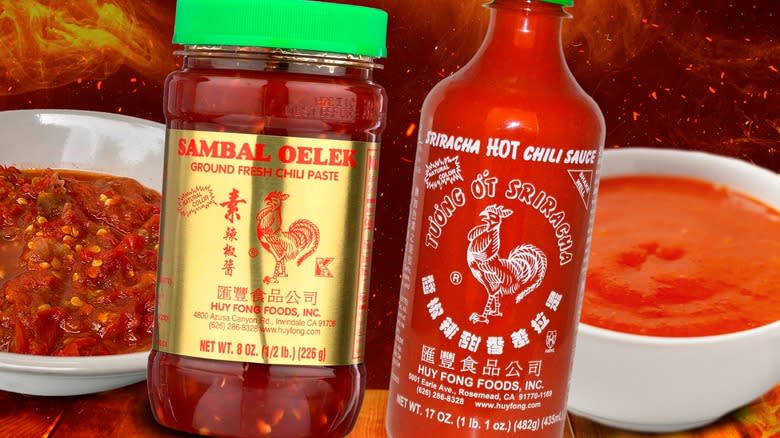
The world of hot sauces has exploded with variety in the past decade. No longer confined to just one or two types of spicy condiments from Louisiana or Mexico, your average grocery shelf now boasts a plethora of options from around the world, each with its own distinct flavor and heat level. And while having a pantry full of options is a dream for some of us, not everyone has the space or desire to buy a bottle of each to try out. Knowing how to pick and choose can be a big help.
Sambal oelek and sriracha are like cousin sauces — both originating in Asia, candy apple red, and the ingredients are fairly similar, featuring mainly chili peppers, salt, and vinegar. Still, the texture and key flavors differ enough that you'll probably have a favorite between the two. Sriracha sauce balances its fermented tangy heat with a bit of garlic and sugar, while sambal oelek flavor is all about the chili pepper, slightly tart with a chunkier texture.
Read more: Styles Of Regional BBQ In The US
What Is Sambal Oelek?
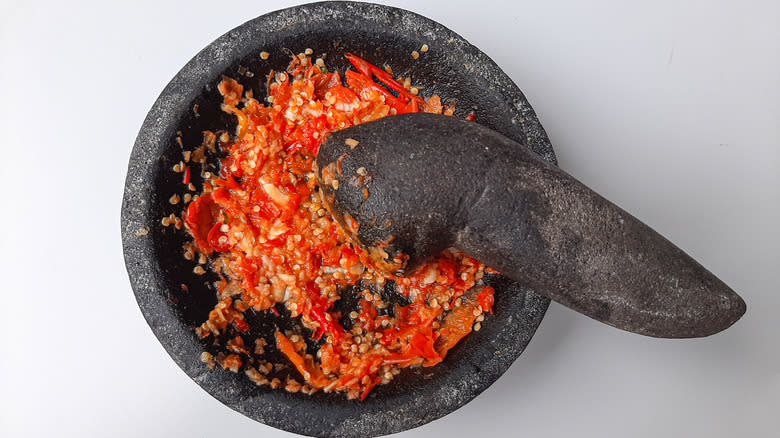
Translating the words in this chili paste's name will give you the first clue to its identity — a grounded chili sauce. In Indonesian, sambal means sauce, while ulek (oelek is the Dutch phonetic spelling) means grind — a reference to the sauce's mortar and pestle origination. This condiment is crafted from fresh red chili peppers, pounded with salt and vinegar to create a vibrant and fiery blend. Its texture is thick and spoonable, with visible flecks of chili seeds. In the U.S., you'll find one or two prominent brands, but in Southeast Asia you'll see dozens of varieties of this pounded spice, blended with other herbs and aromatics.
The main flavor of sambal oelek is the ripe chili pepper but beware — the type of chili is not typically specified on the label. Each company uses one or more chili varieties, so it's hard to know exactly how hot the taste will be from brand to brand. Common choices you may come across include red jalapeño, Thai chili, or Fresno chili, depending on where the paste was made. So, as you might guess, sambal oelek is perfect for adding a blast of spice to a recipe. A spoonful of the paste will also add flecks of red chili since the sauce is not a liquid puree. Many cooks use sambal oelek as a recipe ingredient as well as a condiment, adding it to perk up the heat of a curry or fried rice.
What Is Sriracha?
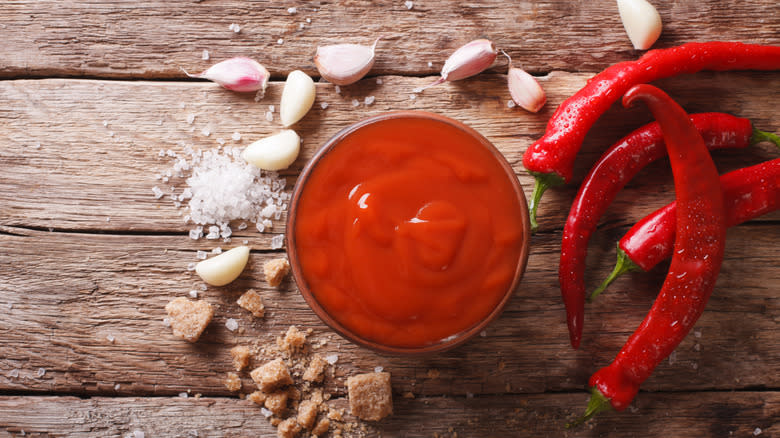
Sriracha almost needs no introduction these days — the most well-known brand, Huy Fong, with the bright green squeeze top, was in the national news when a supply chain problem that brought their sales to a screeching halt, to the consternation of eaters and restaurants alike. The sauce is based on the same chilis that heat up sambal oelek but with the addition of garlic and sugar, blended into a smooth liquid. Additionally, the sauce is allowed to ferment, which adds deeper umami flavor and bright acidity to balance the heat.
Sriracha originally comes from the town of Si Racha, Thailand, where the recipe was developed by one family several generations ago. The blend of sweet, heat, sour, and salt in perfect balance was meant to be an all purpose condiment for Thai foods. The original is still sold in Thailand (and even imported to the U.S.), but Los Angeles-based Huy Fong Foods Inc. has the corner on the U.S. market with its distinctive rooster logo squeeze bottle. Moreover, while the sauce is hot, it's not as hot in Scoville units as an average jalapeño pepper. The beauty of sriracha comes from the balance of flavors. It's great as an all-around condiment for nearly any type of food, and the addictive flavor is even being used for chips and other snacks.
Sambal Is A Simple Chili Paste, While Sriracha Is More Complicated
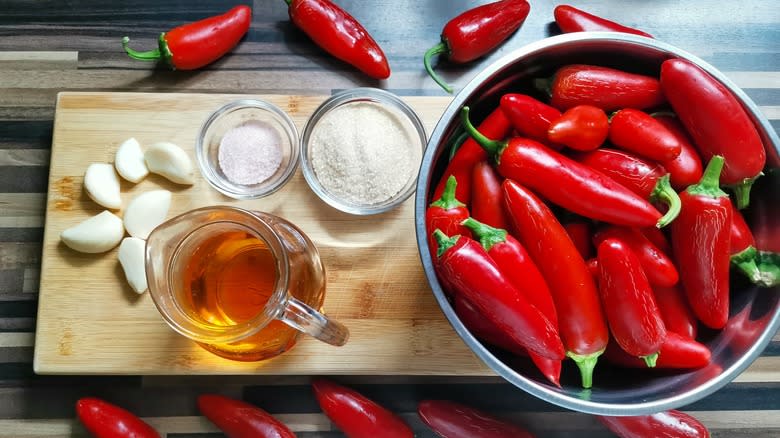
The fresh red of ripe chili peppers is almost all the two sauces have in common. Sambal is more rustic and chunky paste of ground chilis that's been a traditional preparation in Indonesia for centuries. Because there are fewer flavors added to the sambals available in the U.S., fiery chili is the forward flavor you can expect when you crack open a jar. Sambal oelek is the right choice to add when you want to add heat and chili flavor, but not a lot of sweetness or competing flavors — it's a clean, one-ingredient note. In fact, it's not hard to make a batch for yourself if you find fresh chilis at the market — pound them up or pulse them up in the blender with a bit of salt and vinegar to preserve the freshness.
Sriracha, on the other hand, is a relative newcomer in the spice market. The blend of chili with garlic and sugar makes it a balanced addition to a plate, which might account for its huge popularity. During the shortage of Huy Fong sriracha, many cooks took to making their own version of the addictive sauce, which requires a few more ingredients and a lot more time and patience during the fermenting, blending, and straining than simple sambal oelek.
Sriracha Is Fermented, Sambal Oelek Is Not
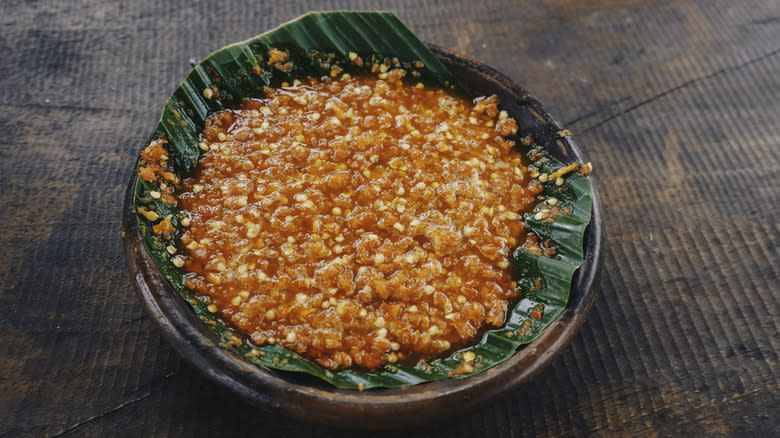
Any tang in sambal oelek comes from vinegar, which is simply mixed into the chili paste. Vinegar and salt are traditional preserving ingredients, which help to keep the paste both fresh-tasting and food-safe — but they also add a layer of flavor to the jar. But don't expect a complex taste — you're getting chili flavor from this jar, and that's a great way to understand what the condiment will add to your food (heat, and plenty of it!).
The magic of many popular hot sauces, including sriracha, comes from the range of flavors that fermenting brings out of fresh fruits and vegetables. With the addition of garlic and sugar, sriracha has a leg up not only on sambal oelek, thanks to its microbial magic, but also on some other hot sauce brands that rely on a single variety of chili. Sriracha brings some mild heat that probably won't bring a tear to your eye, but the complexity of the flavors will keep you coming back for more.
Read the original article on Tasting Table

